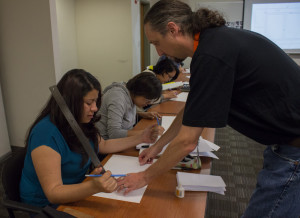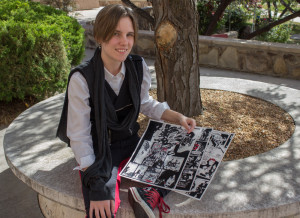Tags
Related Posts
Share This
Creating Comics With Bram Meehan
Comics, whether they are full-length graphic novels or weekday strips, are a complex artistic medium from which contributing faculty member Bram Meehan believes students can learn a great deal. In his Creating Comics class, Meehan strives to help students do just that. The class includes students of all departments and utilizes in-class exercises, short homework assignments and long-term projects. Bram hopes the nature of the class, and the process of creating comics will equip students with a range of skills they can utilize in the professional world.
“I love teaching this class because I watch the light bulbs go off over students’ heads,” Meehan says. “And regardless of their major or drawing ability, once they start to see how comics work, they always discover a way to tell stories that I never saw coming. And I’ve had some terrific network students—some who came to Santa Fe just so they could take this class—who have been a lot of fun to work with and learn from.”
Meehan has a background in graphic design, and is a self-described “comics nerd.” While he and his wife were living in Washington a few years ago, they decided the best way to learn about comics was to make them. They helped found a group of writers, artists, editors and fans called ‘The DC Conspiracy.’ The idea for a comics class that was grounded in Meehan’s background in design was born out of a demand from students.
Meehan believes there is a wide range of skills that students can gain from making comics, including working with the nature of storytelling. He also hopes students harness the necessary professional abilities to meet deadlines, and to talk about the work they produce while taking the class. In addition, Meehan is eager to quell the anxieties of students without drawing abilities, despite the fact that all of the comics they produce will be hand drawn.
“It’s pretty amazing to see students who don’t have drawing training, or who have been told they’re not artists, accept the challenge and really step up,” Meehan says. “The basic rubric for my class — spoiler — means that it’s theoretically possible to do the whole thing with stick figures, but nobody’s taken me up on that. There’s so much more to comics-making than the ability to illustrate; I even say the two are almost two different skills. I think when people see that they can tell a story with whatever level of ability they have, they just want to try to do more and improve, maybe because there’s such a primal attachment to the marks one makes on paper.”
This semester, Meehan is excited about his independent study with Creative Writing senior Michaela Rempel who approached Meehan out of the desire to further her comics abilities before she graduated. Rempel is currently posting a weekly webcomic on her blog. The story is influenced by Japanese rock stars and noir style comics, and takes place in a future where the prohibition era of the early nineteen hundreds never ended.
“My experience was interesting because I had read Sandman and a few other comics here and there but had never touched one in my life,” Rempel says. “In a lot of ways, I feel that you learn more by doing than by watching other people and studying them and that’s the kind of teacher Bram is, he expects that from us. What you get out of it is what you put into it.”
According to Rempel, she already had some skills in drawing when she began the class, but felt these were enhanced by the end of last semester. She also witnessed the opposite in students who were proficient in drawing, that their storytelling abilities increased. According to Meeham, this is one of his hopes for the class: to see students expand their abilities and develop new ones.
“Comics combines text and image in a way no other form does,” Meehan says,
“and still hits on so many topics that cross what modern communications professionals need to succeed, from ideation to executing a process; composition to illustrating time; narrative arc to the biology of storytelling; production to the business of publishing; legibility to making the verbal visual; rendering to creating identifiable characters and environments. No matter what field students are going into, an understanding of — and ability to discuss and present — these kinds of principles will give them an advantage.”








 Jackalope Magazine is the student magazine of Santa Fe University of Art and Design. Building on the interdisciplinary nature of our education, we aim to showcase the talent of our university and character of our city.
Jackalope Magazine is the student magazine of Santa Fe University of Art and Design. Building on the interdisciplinary nature of our education, we aim to showcase the talent of our university and character of our city.
0 Comments
Trackbacks/Pingbacks